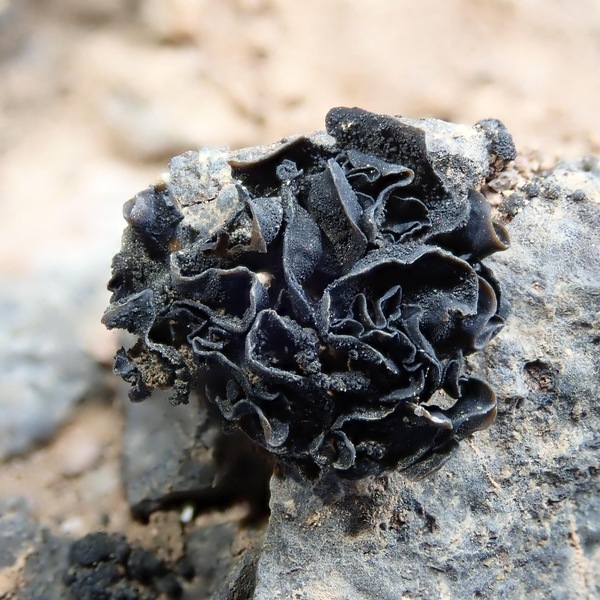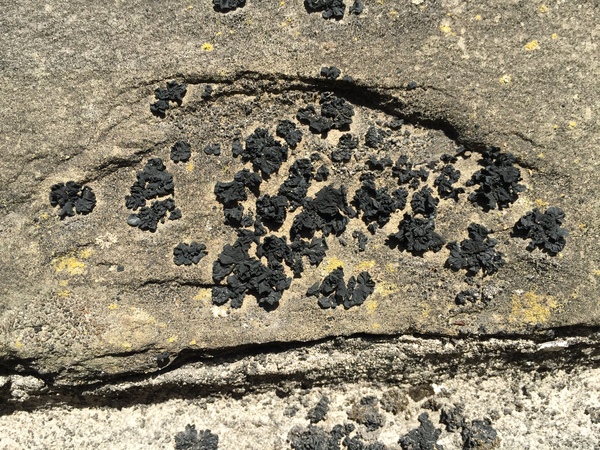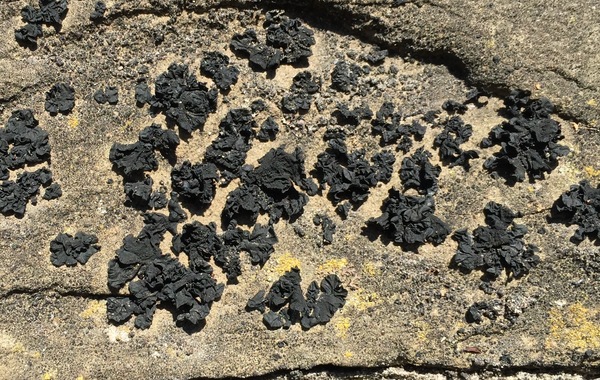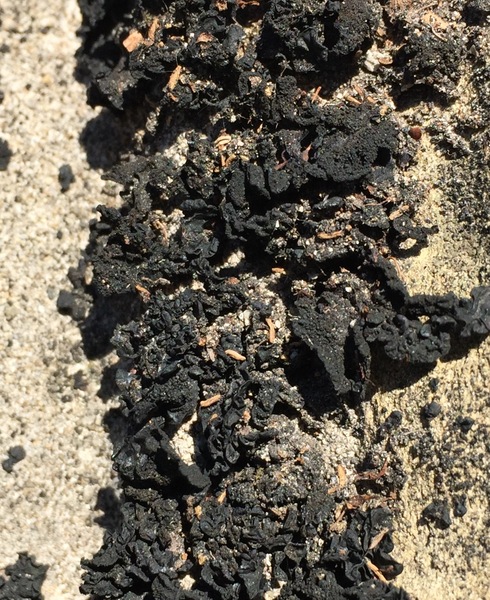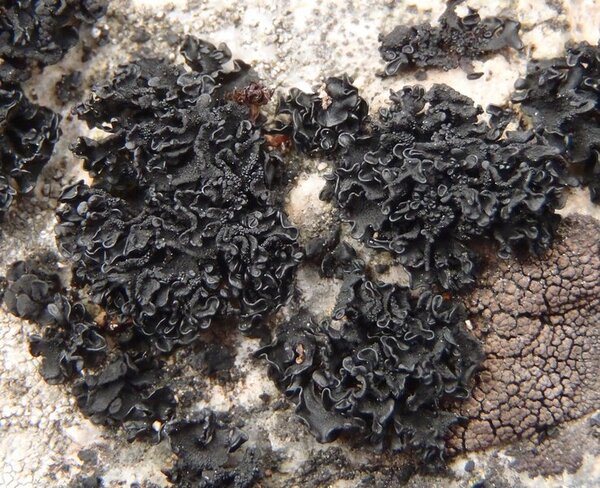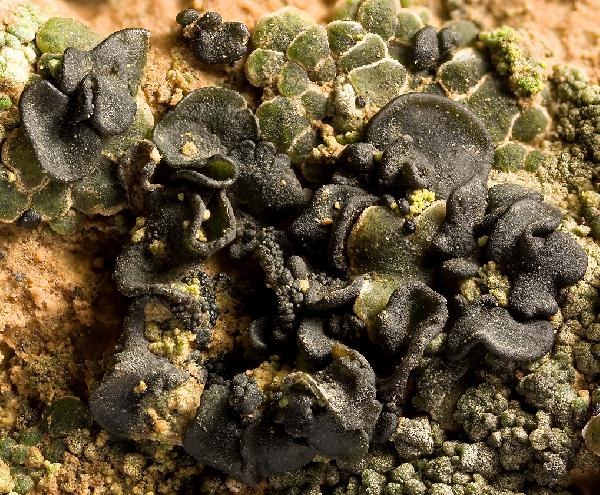Lichinella nigritella (Lettau) P.P. Moreno & Egea
Cryptogamie, Bryol.-Lichénol., 13: 246, 1992. Basionym: Thyrea nigritella Lettau - Beih. Repert. Spec. Nov. Regni Veg., 119: 276, 1942.
Synonyms: Gonohymenia nigritella (Lettau) Henssen; Thallinocarpon nigritellum (Lettau) P.M. Jørg.
Description: Thallus small-foliose to squamulose-umbilicate, polyphyllous, gelatinous when wet, forming regular to irregular, up to 3 cm wide cushions, black, dull to glossy, very rarely with patches of grey pruina, soon covered in minute, globose 0.1-0.3 µm wide isidia, densely lobulate, the lobules at first adpressed, but soon ascending to erect in central parts of thallus, 1-2 mm wide at base and 3-4 mm wide at tips, broadly rounded at first but soon divided, with ascending, thicker margins; lower surface attached by a central holdfast. Thallus 0.2-0.4 µm thick, the outer part 50-70 µm thick, formed by short-celled, mainly anticlinally oriented hyphae enclosing the photobiont cells, the medullary part of loosely to densely arranged (forming a 50-100 µm thick compact strand), 1-2 µm thick hyphae with cylindrical cells, lacking photobionts. Apothecia thallinocarps, hemiangiocarpous, the ascogonia arising freely beneath the thallus surface, rare, marginal to apical, 0.3-0.6 mm across, immersed and difficult to recognize unless when wet, with a rough disc and an up to 50 µm wide, indistinct thalline margin. Proper exciple absent; hymenium 110-150 µm high, separated into partial hymenia by intrusions of wedge-shaped, sterile thalline tissue, covered by a continuous layer of sterile tissue separated by the pore-like discs of the partial hymenia, K/I+ blue turning wine-red; subhymenium hyaline, continuous, 50(-100) µm thick, K/I+ blue. Asci 16-24-spored, subcylindrical to obclavate, prototunicate, with a thin, one-layered, non-amyloid wall, an amyloid external apical cap, and passive spore discharge via apical rupturing, Lichina-type. Ascospores 1-celled, hyaline, broadly ellipsoid, 6-8 x 3-4 µm. Pycnidia rare, globose, immersed. Conidia ellipsoid, 4-5 x 1.5 µm. Photobiont cyanobacterial, chroococcoid, th cells single, measuring 6-12 x 6-10 µm, penetrated by haustoria and surrounded by a brownish gelatinous sheath. Spot tests: all negative. Chemistry: without lichen substances.
Growth form: Fruticose
Substrata: rocks
Photobiont: cyanobacteria, coccaceous (e.g. Gloeocapsa)
Reproductive strategy: mainly sexual
On otherwise dry surfaces with short periods of water seepage after rain
Commonnes-rarity: (info)
Alpine belt: absent
Subalpine belt: absent
Montane belt: very rare
Dry submediterranean belt: rather rare
Humid submediterranean belt: rare
Padanian area: extremely rare
pH of the substrata:
1 2 3 4 5
Solar irradiation:
1 2 3 4 5
Aridity:
1 2 3 4 5
Eutrophication:
1 2 3 4 5
Poleotolerance:
0 1 2 3
Altitudinal distribution:
1 2 3 4 5 6
Rarity
absent
extremely rare
very rare
rare
rather rare
rather common
common
very common
extremely common
Loading data...
Occurrence data
Predictive map

P.L. Nimis; Owner: Department of Life Sciences, University of Trieste
Herbarium: TSB (8273)
2002/01/02
isidia
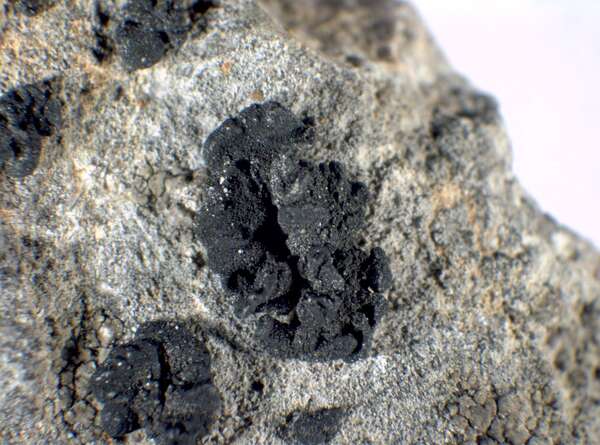
P.L. Nimis; Owner: Department of Life Sciences, University of Trieste
Herbarium: TSB (17383)
2001/12/09
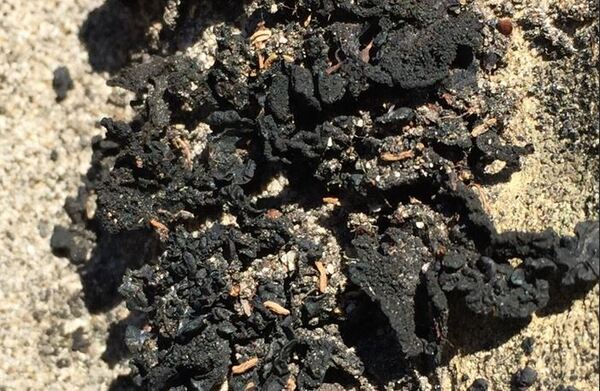
Pier Luigi Nimis; Owner: Department of Life Sciences, University of Trieste
Italy, Friuli Venezia Giulia, Trieste, Trieste Coast near Tenda Rossa, on a wall of calciferous sandstone
07/2016
Growth form: Fruticose
Substrata: rocks
Photobiont: cyanobacteria, coccaceous (e.g. Gloeocapsa)
Reproductive strategy: mainly sexual
On otherwise dry surfaces with short periods of water seepage after rain
Commonnes-rarity: (info)
Alpine belt: absent
Subalpine belt: absent
Montane belt: very rare
Dry submediterranean belt: rather rare
Humid submediterranean belt: rare
Padanian area: extremely rare
pH of the substrata:
| 1 | 2 | 3 | 4 | 5 |
Solar irradiation:
| 1 | 2 | 3 | 4 | 5 |
Aridity:
| 1 | 2 | 3 | 4 | 5 |
Eutrophication:
| 1 | 2 | 3 | 4 | 5 |
Poleotolerance:
| 0 | 1 | 2 | 3 |
Altitudinal distribution:
| 1 | 2 | 3 | 4 | 5 | 6 |
Rarity
absent
extremely rare
very rare
rare
rather rare
rather common
common
very common
extremely common
Loading data...
Occurrence data
Predictive map

P.L. Nimis; Owner: Department of Life Sciences, University of Trieste
Herbarium: TSB (8273)
2002/01/02
isidia

P.L. Nimis; Owner: Department of Life Sciences, University of Trieste
Herbarium: TSB (17383)
2001/12/09



